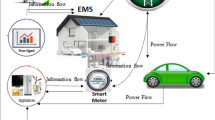Abstract
Modern power systems are witnessing a noticeable increase in the integration of low-inertia renewable sources which require robust control schemes to damp out low-frequency oscillations emerged by this expansion. This paper proposes a reinforcement learning (RL)-based controller using a deep deterministic policy gradient (DDPG) algorithm to damp inter-area oscillations. The learning process of the controller is enhanced using a discrete reward-function which is selected to be a reciprocal function of the input error. To allow the agent to drive the total error lower and lower, both the absolute error and integral of error are included in the observation state vector. A two-area system with a solar plant integrated is used as the test system. The controller obtains its global input signal from PMU devices in wide-area measurement systems using frequency information. A comprehensive analysis is presented using several analytical control tools including time-domain simulation, pole-zero plot, mode shape, frequency response, and participation factor map. Furthermore, a package of programs has been developed for this study using MATLAB and Simulink. The communication latency is also included in the design of the controller considering constant and variable practical values of latency. The proposed controller demonstrates its effectiveness in damping inter-area oscillation and improving the system stability.



















Similar content being viewed by others
References
Hashmy Y, Yu Z, Shi D, Weng Y (2020) Wide-area measurement system-based low frequency oscillation damping control through reinforcement learning. IEEE Trans Smart Grid 11(6):5072–5083. https://doi.org/10.1109/TSG.2020.3008364
Abdulrahman I, Belkacemi R, Radman G (2021) Power oscillations damping using wide-area-based solar plant considering adaptive time-delay compensation. Springer J Energy Syst 12:459–489
Cao D et al (2020) Reinforcement learning and its applications in modern power and energy systems: a review. J Modern Power Syst Clean Energy 8(6):1029–1042. https://doi.org/10.35833/MPCE.2020.000552
Sewak M (2019) Deep reinforcement learning frontiers of artificial intelligence. Springer Nature Pte Ltd, Singapore
Dong H et al (2020) Deep reinforcement learning fundamentals research and applications. Springer Nature Pte Ltd, Springer
Zhang G, Hu W, Zhao J, Cao D, Chen Z, Blaabjerg F (2021) A novel deep reinforcement learning enabled multi-band PSS for multi-mode oscillation control. IEEE Trans Power Syst 36(4):3794–3797. https://doi.org/10.1109/TPWRS.2021.3067208
Gupta P, Pal A, Vittal V (2022) Coordinated wide-area damping control using deep neural networks and reinforcement learning. IEEE Trans Power Syst. https://doi.org/10.1109/TPWRS.2021.3091940
Lee H et al (2019) Artificial neural network control of battery energy storage system to damp-out inter-area oscillations in power systems. Energies 12:3372. https://doi.org/10.3390/en12173372
Younesi A (2017) Application of reinforcement learning for generating optimal control signal to the IPFC for damping of low- frequency oscillations. Wiley Trans Electr Energ Syst. https://doi.org/10.1002/etep.2488
Liu F et al (2016) Robust wide-area damping controller design for inter-area oscillations with signals’ delay. Wiley Trans Electr Energ Syst 11:206–215
Chen C, Cui M, Li F, Yin S, Wang X (2021) Model-free emergency frequency control based on reinforcement learning. IEEE Trans Industr Inf 17(4):2336–2346
Zhang G et al (2020) Deep reinforcement learning-based approach for proportional resonance power system stabilizer to prevent ultra-low-frequency oscillations. IEEE Trans Smart Grid 11(6):5260–5272. https://doi.org/10.1109/TSG.2020.2997790
Yan Z et al (2020) Deep reinforcement learning-based optimal data-driven control of battery energy storage for power system frequency support. In IET Gen Trans Dis. https://doi.org/10.1049/iet-gtd.2020.0884
Abouheaf M et al (2019) Load frequency regulation for multi-area power system using integral reinforcement learning. IET Gen Transm Distrib. https://doi.org/10.1049/iet-gtd.2019.0218
Zheng Y et al (2021) Power system load frequency active disturbance rejection control via reinforcement learning-based memetic particle swarm optimization. IEEE Access 9:116194–116206. https://doi.org/10.1109/ACCESS.2021.3099904
Yan Z, Xu Y (2019) Data-driven load frequency control for stochastic power systems: a deep reinforcement learning method with continuous action search. IEEE Trans Power Syst 34(2):1653–1656. https://doi.org/10.1109/TPWRS.2018.2881359
Chen X et al (2021) Reinforcement learning for decision-making and control in power systems: Tutorial, Review, and Vision, in arXiv: 2102.01168
Yang T etal (2020) Reinforcement learning in sustainable energy and electric systems: a survey, in Elsevier Annual Reviews in Control
Zhang Z, Zhang D, Qiu RC (2020) Deep reinforcement learning for power system applications: an overview. CSEE J Power and Energy Syst 6(1):213–225. https://doi.org/10.17775/CSEEJPES.2019.00920
Glavic M (2019) (Deep) Reinforcement learning for electric power system control and related problems: a short review and perspectives, in Elsevier Annual Reviews in Control
Zhang D, Han X, Deng C (2018) Review on the research and practice of deep learning and reinforcement learning in smart grids. CSEE J Power and Energy Syst 4(3):362–370. https://doi.org/10.17775/CSEEJPES.2018.00520
Siraskar R (2021) Reinforcement learning for control of valves. Elsevier Mach Learn Appl. https://doi.org/10.1016/j.mlwa.2021.100030
Abdulrahman I, Radman G (2018) Wide-area-based adaptive neuro-fuzzy SVC controller for damping interarea oscillations. Can J Electric Comput Eng 41(3):133–144
WECC Renewable Energy Modeling Task Force (2014) WECC solar plant dynamic modeling guidelines
Sandia National Laboratories (2013) Generic solar photovoltaic system dynamic simulation model specification”, California
Islam MR, Rahman F, Xu W (2016) Green energy and technology: advances in solar photovoltaic power plants. Springer, Berlin
Pauer P, Pai MA, Chow JH (2017) Power system dynamics and stability, 2nd edn. Wiley, Amsterdam
Kundur P et al (2004) Definition and classification of power system stability IEEE/CIGRE joint task force on stability terms and definitions. IEEE Trans Power Syst 19(3):1387–1401
Pal B, Chaudhuri B (2005) Robust control in power system. Springer, New York
Funding
Not applicable.
Author information
Authors and Affiliations
Corresponding author
Ethics declarations
Conflict of interest
There are no competing interests in this manuscript.
Additional information
Publisher's Note
Springer Nature remains neutral with regard to jurisdictional claims in published maps and institutional affiliations.
Supplementary Information
Below is the link to the electronic supplementary material.
Supplementary file1 (MP4 64950 kb)
Rights and permissions
Springer Nature or its licensor holds exclusive rights to this article under a publishing agreement with the author(s) or other rightsholder(s); author self-archiving of the accepted manuscript version of this article is solely governed by the terms of such publishing agreement and applicable law.
About this article
Cite this article
Abdulrahman, I. Reinforcement-learning-based damping control scheme of a PV plant in wide-area measurement system. Electr Eng 104, 4213–4225 (2022). https://doi.org/10.1007/s00202-022-01615-3
Received:
Accepted:
Published:
Issue Date:
DOI: https://doi.org/10.1007/s00202-022-01615-3




